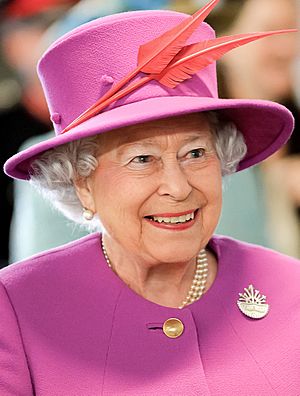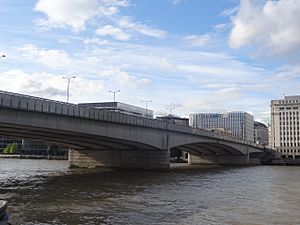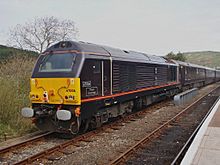Operation London Bridge facts for kids

Operation London Bridge was the secret plan for what would happen when Queen Elizabeth II passed away. It included how her death would be announced, the period of official mourning, and all the details for her state funeral. This plan was first created in the 1960s and was updated many times over the years until her death in 2022.
The special phrase "London Bridge is down" was used to tell the prime minister and other important people that the Queen had died. This phrase started the whole plan. Many groups helped prepare the plan, including government departments, the Church of England, the police, the British Armed Forces, and the media. Even the Queen herself made some important decisions about the plan. The Guardian newspaper said the plans were "planned to the minute" and had "very specific" details.
Other plans worked alongside Operation London Bridge. For example, Operation Unicorn was the plan for what would happen if the Queen died in Scotland. This is exactly what happened. There were also plans for King Charles III becoming king and his coronation. Many Commonwealth realms (countries where the Queen was also head of state) also had their own plans for her passing.
Contents
How the Plans Started
Funerals and coronations for the Royal Family are usually organized by the Earl Marshal and the College of Arms. The Cabinet Office also helped prepare for Queen Elizabeth II's death and funeral.
For a long time, special "codewords" have been used for royal death and funeral plans. These codewords were first used so that telephone operators at Buckingham Palace wouldn't find out about a royal death before the public announcement. When King George VI died in 1952, officials were told using the phrase "Hyde Park Corner".
Many royal funeral plans in recent times have used the names of famous bridges in the United Kingdom. For example, Operation Tay Bridge was the plan for Queen Elizabeth The Queen Mother's death and funeral. This plan was practiced for 22 years before it was used in 2002. The funeral of Diana, Princess of Wales, was also based on Operation Tay Bridge. In 2017, Operation Forth Bridge was the plan for Prince Philip, Duke of Edinburgh, who died in 2021. The plan for King Charles III is called Operation Menai Bridge. All these royal death plans are part of a bigger plan called Operation Lion.
The Main Plan

Plans for Queen Elizabeth II's death and funeral began in the 1960s and changed many times over the years. The plan that covered everything from the Queen's death to her funeral was called Operation London Bridge.
When the Queen died, her private secretary would be the first official to share the news. They would call the prime minister and use the code phrase "London Bridge is down" on secure phone lines. Other important government officials would also be told. The Foreign, Commonwealth and Development Office would then tell the governments of the 14 other countries where Elizabeth was Queen, and other Commonwealth of Nations countries. Government websites and social media accounts, along with the royal family's website, would turn black.
The news media would be told through special alert systems. BBC Two would stop its regular shows and switch to BBC One's broadcast. BBC News would show pre-recorded images, and presenters would change into dark clothes for the announcement. Newspapers like The Times had 11 days of news coverage already prepared.
A special notice with a dark border would be put on the gates of Buckingham Palace. The palace website would show the same notice. The Parliament of the United Kingdom and the parliaments in Scotland, Wales, and Northern Ireland would meet quickly. The prime minister would speak to the House of Commons. The new monarch would meet the prime minister and then give a speech to the nation at 6 pm on the evening after the Queen's death. Flags on government buildings would fly at half-mast. Books of condolence might be opened for people to write messages. Gun salutes would happen, and a special service would be held at St Paul's Cathedral.
Ten days after the Queen's death, a state funeral led by the Archbishop of Canterbury would be held at Westminster Abbey. Her body would then be buried in a special tomb at King George VI Memorial Chapel in St George's Chapel, Windsor Castle. Prince Philip, Duke of Edinburgh's coffin would be moved to be buried next to her. The day of the funeral would be a day of national mourning. A two-minute silence would take place across the United Kingdom at midday.
Supporting Operations
Operation London Bridge included other plans for specific arrangements. For example, Operation Marquee covered the ceremonies and vigils for the Queen's lying-in-state inside Westminster Hall. Operation Feather dealt with how the public would be managed outside the building.
There were also plans for moving the Queen's coffin, depending on where she died. If she died at Windsor Castle or Sandringham House, her coffin would have been taken by Royal Train to St Pancras railway station in London.
Operation Overstudy
Operation Overstudy was the plan if the Queen had died outside the UK. In this case, her coffin would have been flown to RAF Northolt by a special plane. Then, it would be taken by a hearse to Buckingham Palace. Five days after her death, the coffin would have been moved to Westminster Hall for her to lie in state for three days.
Operation Unicorn
Operation Unicorn was the plan for the Queen's death in Scotland. Details about this plan became public in 2019.
If the Queen died in Scotland, Holyrood Palace, St Giles' Cathedral, and the Scottish Parliament would be central locations. A condolence book would be available at the Parliament. The Scottish Parliament would stop its work for at least six days to prepare for the funeral. The Queen's coffin would first rest at Holyrood Palace, then a service would be held at St Giles' Cathedral in Edinburgh. After this, the coffin would be taken to Waverley station and travel by Royal Train to London if possible. If not, it would be flown to London by plane, which was part of Operation Overstudy.
Related Operations
The plans for the Queen's death and funeral happened at the same time as other related plans. These included the plans for King Charles III becoming king, called Operation Spring Tide, and his coronation plans, called Operation Golden Orb.
Operation Spring Tide
Operation Spring Tide was the plan for Charles III becoming king. One day after the Queen's death, the Accession Council would meet at St James's Palace, and Charles would be officially announced as king. Parliament would meet that evening, and MPs would promise loyalty to Charles III. Charles III would then meet the prime minister and other important government officials. Two days after the Queen's death, proclamations for the King would be made in Scotland, Wales, and Northern Ireland.
On the third day, Charles III would receive messages of condolence at Westminster Hall. He would then begin a tour of the United Kingdom. He would visit the Scottish parliament and attend a service in Edinburgh. The next day, he would visit Northern Ireland. Seven days after the Queen's death, Charles III would visit Wales.
There were also supporting plans within Operation Spring Tide for each part of the UK: Operation Shamrock for Northern Ireland, Operation Kingfisher for Scotland, and Operation Dragon for Wales.
How the Plans Were Used
Operation London Bridge and Operation Unicorn were put into action when Elizabeth II passed away on 8 September 2022 at Balmoral Castle in Scotland.
The plan called the day of her death "D-day." However, because she died late in the day, the next day, 9 September, was officially named D-day. This also helped make sure the funeral (on D+10) didn't fall on a Sunday.
One change from the original plan was that Charles III announced that the day of the Queen's funeral would be a bank holiday.
Even though the Queen did not die overseas, a military plane—the RAF's C-17 Globemaster—was used to transport her coffin to London. This was done for security reasons, as officials worried that the Royal Train might be a target for protesters.
Plans in Other Countries
Officials from Buckingham Palace and Clarence House worked with representatives from the Commonwealth realms to share information about Operation London Bridge and the succession plans. The governments of these countries were told about the Queen's death by the UK's Foreign, Commonwealth and Development Office. These countries had also made their own plans for what would happen after Elizabeth II's death.
Australia
Australia had prepared for the Queen's death. Statements were already written for the prime minister and governor-general.
The prime minister would be told about the Queen's death about an hour before it was announced to the public. The prime minister would wear a black tie after the announcement. The prime minister and governor-general would then go to Canberra to make their statements. They would then travel to London. If the Parliament was not meeting, it would be called back to pass a motion of condolence. The governor-general would officially announce King Charles III as the new monarch in Australia.
Flags would fly at half-mast for ten days, except on the day Charles III was proclaimed king. Australia's response would also include a national day of remembrance, which might be a public holiday. A state funeral and a special church service would be held. The Australian Defence Force would perform gun salutes and take part in ceremonies in the United Kingdom.
Canada
In Canada, preparations began as early as 2002. The plans involved the Canadian Armed Forces, the Privy Council Office, and other government departments. Provincial governments in Canada also had their own plans for the Queen's death and Charles III becoming king.
After hearing the news, the governor general would call the Cabinet to Parliament Hill. The Privy Council for Canada would meet to proclaim Charles III as king in Canada. The prime minister would call Parliament to order to express loyalty and condolences to the new monarch. The Canadian High Commissioner to the United Kingdom would represent Canada at the Accession Council.
An official mourning period would take place in Canada. During this time, a national memorial parade and service would be held in Ottawa. Flags on all federal buildings would fly at half-mast from the announcement of death until sunset on the day of the funeral.
Special clothing would be worn during the mourning period. Staff of the governor-general and other officials would wear black ties and armbands. The Canadian Broadcasting Corporation (CBC) had a plan for the Queen's death, which they called a "Broadcast of National Importance." Regular shows would be stopped, and all CBC television and radio stations would switch to 24-hour news.
New Zealand
In New Zealand, the Cabinet Office was in charge of planning for the Queen's death.
New Zealand would receive the news of Queen Elizabeth II's death through special communication channels. Once informed, the head of the Ministry for Culture and Heritage would ask for the flag of New Zealand to fly at half-mast on government buildings until the day of the funeral, except on the day the new monarch was proclaimed. Twenty-one gun salutes would also be fired. A state memorial service was expected, and the prime minister would decide on other events. New Zealand Defence Force members would take part in ceremonies overseas.
Radio New Zealand (RNZ), the state radio broadcaster, had guidelines for the death of the monarch. All RNZ stations would interrupt their regular shows to announce the Queen's death and provide continuous news coverage. RNZ stations were not allowed to play punk music or songs by the band Queen during this time.
See also
 In Spanish: Operación Puente de Londres para niños
In Spanish: Operación Puente de Londres para niños



